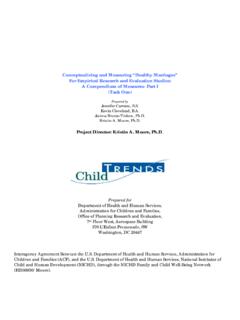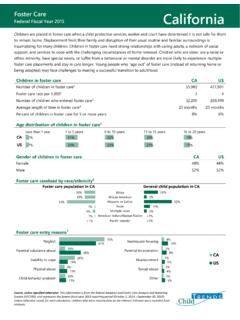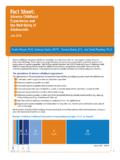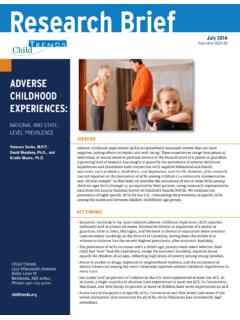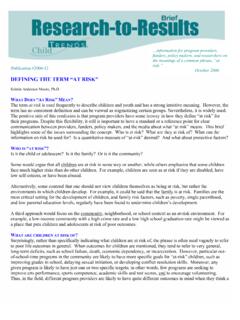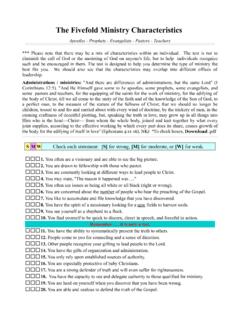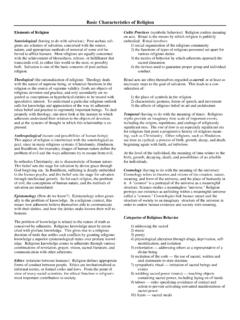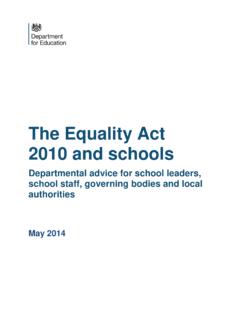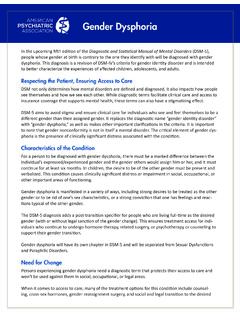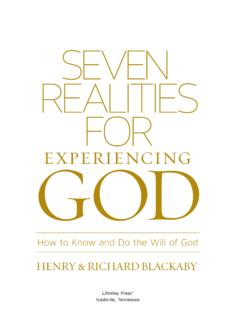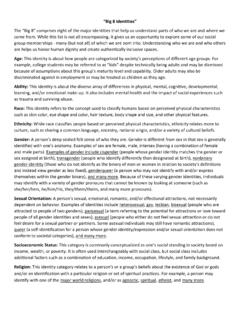Transcription of Religion and Spirituality in Childhood and Adolescence
1 Religion and Spirituality in Childhood and Adolescenc e Lisa J. Bridges, Ph .D . with Kristin A. Moore, Chil January, 2002. Religion and Spirituality in Childhood and Adolescenc e Lisa J. Bridges, Ph .D. with Kristin A. Moore, Ph .D. January, 200 2. A Conceptual and Theoretical Overview of Religious and Spiritual Development in Childhoo d and Adolescence ..: .. 3. Elkind' s Studies of Religious Development .. 4. Fowler' s Faith Development Theory .. 6. Oser's Theory of the Development of Religious Judgment .. 9. Kirkpatrick's Attachment-Theoretical Perspective on Individual Differences in Religiosi ty .. 1 1. Conceptual Links Between Child and Adolescent Religiosity and Other Aspects of Well-Being Social Capital and S oci al S uppor t .. 13. Health Promotion .. 13. Promotion of Prosocial Behavior .. 1 4. Provision of Purpose and Meaning .. 1 5. Conceptual Links Between Parental and Familial Religiosity or Spirituality and Child and Adolescent Well-Being.
2 1 5. Social .. 1 6. Health Promo tion .. 1 6. Direct Effects of Religiosity on Parenting .. 1 7. Indirect Effects of Religiosity on Parenting .. 2 1. Religiosity and Parental Modeling .. 24. Measurement of Religiosity in Childhood and Adolescence .. 25. Review of Empirical Evidence Regarding Religiosity and Well-Being in Childhood an d Adolescence .. 29. Delinquency and Risk-Taking Behavior .. 30. Prosocial and Moral Values and Behavior .. 39. Personality and Mental Health .. 41. Other Aspects of Adolescent Well-Being .. 45. Summary .. 45. Review of Empirical Evidence Regarding Parental Religiosity and Well-Being in Childhood and Adolescence .. 4 6. Conclusions .. 49. Implications .. 5 1. References .. 53. 2. Religious faith, beliefs, and activities are important aspects of the lives of America n adolescents . Although researchers have found a general age trend for religiousness to declin e from Childhood through Adolescence (Benson, Donahue, & Erickson, 1989 ; King, Elder, &.)
3 Whitbeck, 1997), the percentage of American high school seniors who self-reported church attendance at least monthly was highly stable from 1987 through 1994, ranging from a low o f 46% in 1990 to a high of 50% in 1992 (Donahue & Benson, 1995). These percentages wer e derived from Monitoring the Future reports published by the Institute for Social Research at th e University of Michigan, based on annual nationwide surveys of a nationally representativ e sample . Using the same annual survey, Youniss, McLellan, and Yates (1999) reported that ove r 60% of high school seniors reported that Religion was "pretty " or "very" important to them. Thi s percentage w as highly consistent across the decades of the 1970s, 1980s , and 1990s . A substantial body of literature exists in the social and behavioral sciences o n associations between Religion , Spirituality , and well-being in adulthood . Depending upon the types of measures of religiosity and Spirituality utilized and the outcomes assessed, results wit h adults support low but significant positive associations between religiosity and components o f well-being, including substance abuse, mental health, physical health, and general life satisfaction (e.
4 G., Ellison, 1991 ; Ellison, 1993, Fischer & Richards, 1998 ; George, Larson, Koenig, & McCullough, 2000) . Despite the obvious importance of Religion in the lives o f children and adolescents, however, considerably less attention has been paid to associations between religiosity and well-being prior to adulthood . In this report, we will begin with a brief discussion of theories of religious development . This will be followed by sections outlining possible mechanisms for associations between child and adolescent religiosity, parental religiosity, and well-being . The fourth section will discuss issues pertaining to the measurement of religiosity and Adolescence in Childhood and Adolescence . Fifth, two sections will draw together recent empirical reports attempting to evaluate the contributions of religiosity to child and adolescent well-being, primarily focusing on work pertaining to religiosity and well-being prior to the college years.
5 The final section will summarize the research, summarize issues to be addressed in future research, and will present some possible implications of the research literature for intervention and treatment programs . A Conceptual and Theoretical Overview of Religious and Spiritual Developmen t in Childhood and Adolescenc e A consensus report prepared by a panel convened by the National Institute for Healthcare Research (NIHR ; see George et al ., 2000) defined Spirituality as behaviors, cognitions, and emotions that arise as part of an individual's search for connection with a divine being, a higher power, or an ultimate truth . Religion or religiousness may also involve a search for the spiritual, as it is undertaken within a collective (i .e ., a church or some other type of religious community). that provides guidance, validation, and support for the methods with which that search is conducted.
6 This definition of religiousness is similar to Allport's description of intrinsic religiosity (Allport & Ross, 1967) . The NIHR panel (George et al ., 2000) also identified a second type of religiousnes s characterized by the same collectivity described above, but with different underlying goals . This form of religiousness involves participation in a religious community in order to reach goals that are not inherently spiritual in nature, such as opportunities for social interaction or financial gain . This definition is consistent with Allport and Ross' (1967) description of extrinsic religiosity . Theoretically, the distinction between these two types of religiosity is relevant for understanding whether positive effects of religiousness are primarily due to the benefits of membership in a 4. supportive community (a social support or social bonding perspective), or whether religiousness may contribute to well-being for reasons that are more tied to personal faith-such as an sense of purpose or meaning in life.
7 The meanings of religious participation and of religious beliefs change across the cours e of development . Most theories of religious development have as their foundation the cognitive developmental theory of Piaget (e .g ., Piaget, 1962 ; Piaget & Inhelder, 1958) . The focus of these theories is on the structure of religious thought as it changes across time, rather than on the content of religious beliefs . Notable among these theories are those of Elkind (e .g. 1964, 1970). Goldman (1964), Fowler (e .g., Fowler, 1991 ; Osmer & Fowler, 1985), and Oser (e .g ., 1991) . These theories have in common the proposal that religious thinking, in conjunction with other areas of thinking, moves from concrete imagery and literal beliefs in Childhood to more abstract religious thinking in Adolescence . Thus, it is only in Adolescence that religious beliefs and values are expected to begin to take on the same meanings that they have in adulthood.
8 In the following sections, we will briefly review the theories of religious development elaborated by Elkind, Fowler, and Oser, as well as Kirkpatrick's attachment theoretical perspective on the development of individual differences in religiosity (Kirkpatrick, 1997 ; Kirkpatrick & Shaver, 1990) . Elkind's Studies of Religious Development. In Adolescence and adulthood, individuals understand that different religions an d religious denominations have different foundational beliefs, including different beliefs about the nature of god (or gods) and humankind, and the relationship between the two as expressed through worship, prayer, and the activities of daily life . When older adolescents and adults self report denominational affiliations, therefore, they are not simply identifying the church that they attend, but are rather identifying a set of religious practices to which they adhere, and the religious beliefs that underlie these practices (at least to the extent that the individual perceives their Religion to be important in their lives).
9 Elkind (1964 ; 1970) found that such understanding of religious beliefs and practices is not present in young children, but rather develops across Childhood . Elkind proposed that there are three stages of religious development in Childhood and Adolescence that parallel th e preoperational, concrete operational, and formal operational stages of cognitive development described by Piaget. (Stage I thinking is characteristic of preschool-age children . In this stage, preoperationa l children are beginning to use signs and symbols to represent objects in their real lives . They are able to use categorical thinking, but they have little ability to understand what distinguishes categories from each other, or that an individual or object can be classified into more than one category at the same time . Young children cannot, for example, understand that an individual can be Catholic and American at the same time.)
10 Children who are raised in a Religion may know the name of their denomination, and that the name of the denomination represents something about individuals who belong to that denomination, but they have very little understanding of what distinguishes one denomination from another. Stage 2, spanning the elementary school years, represents an increased level o f understanding about Religion and religious beliefs . In keeping with the concrete operational thought that characterizes children of this age, however, thinking about Religion is also based on observable behavior, rather than on thoughts, feelings, and motivations . Children understand that denominations differ in their religious activities, but they have much less understanding about the differences in religious beliefs that underlie different activities . Similarly, when children at this age are asked to describe prayer, they focus on the activity of prayer, rather than on the inner feelings and beliefs that older individuals may explore and express in prayer.


